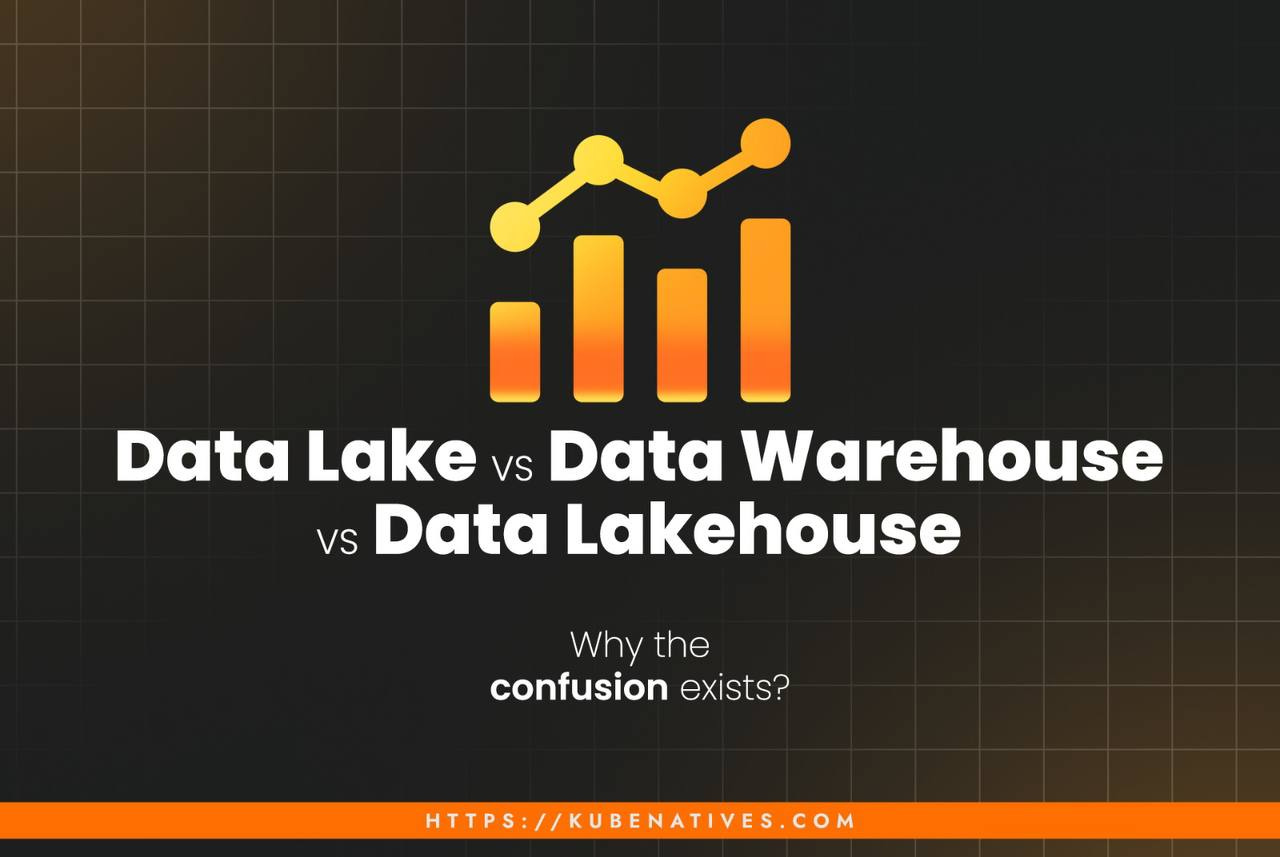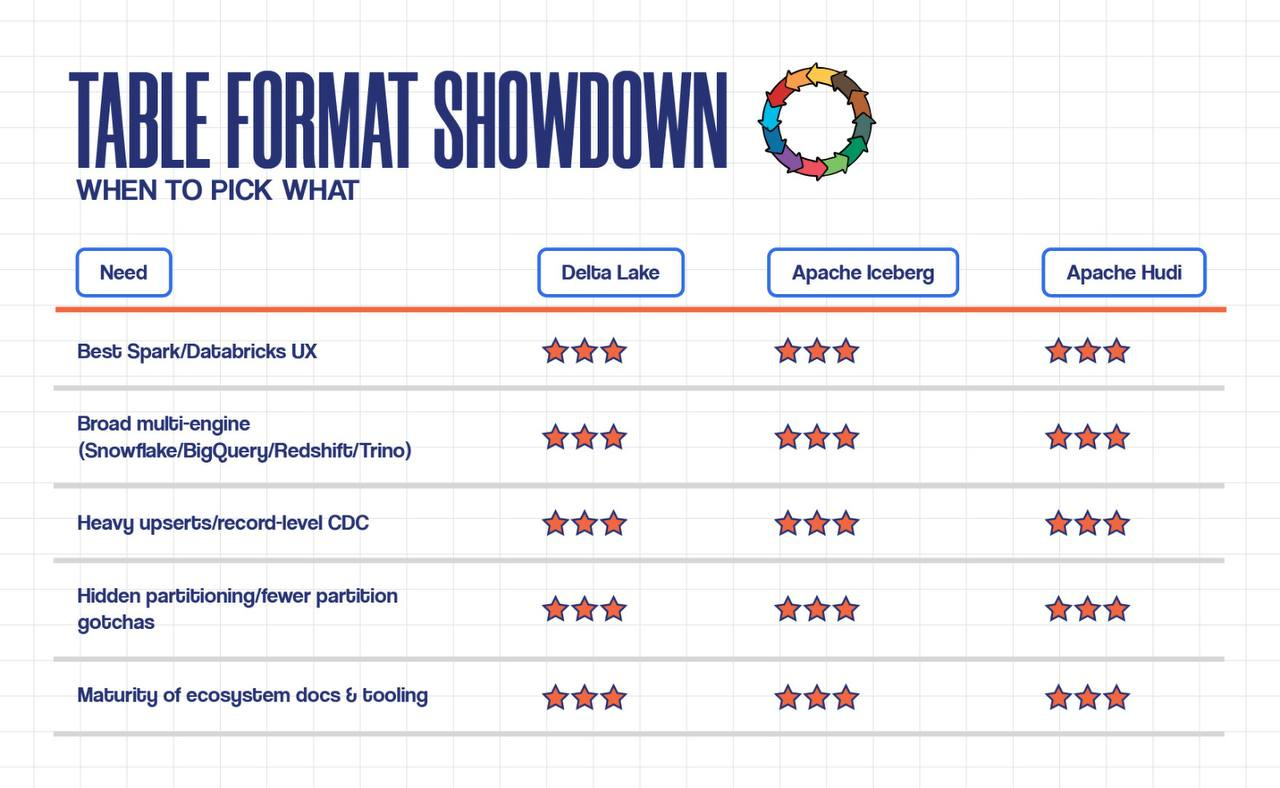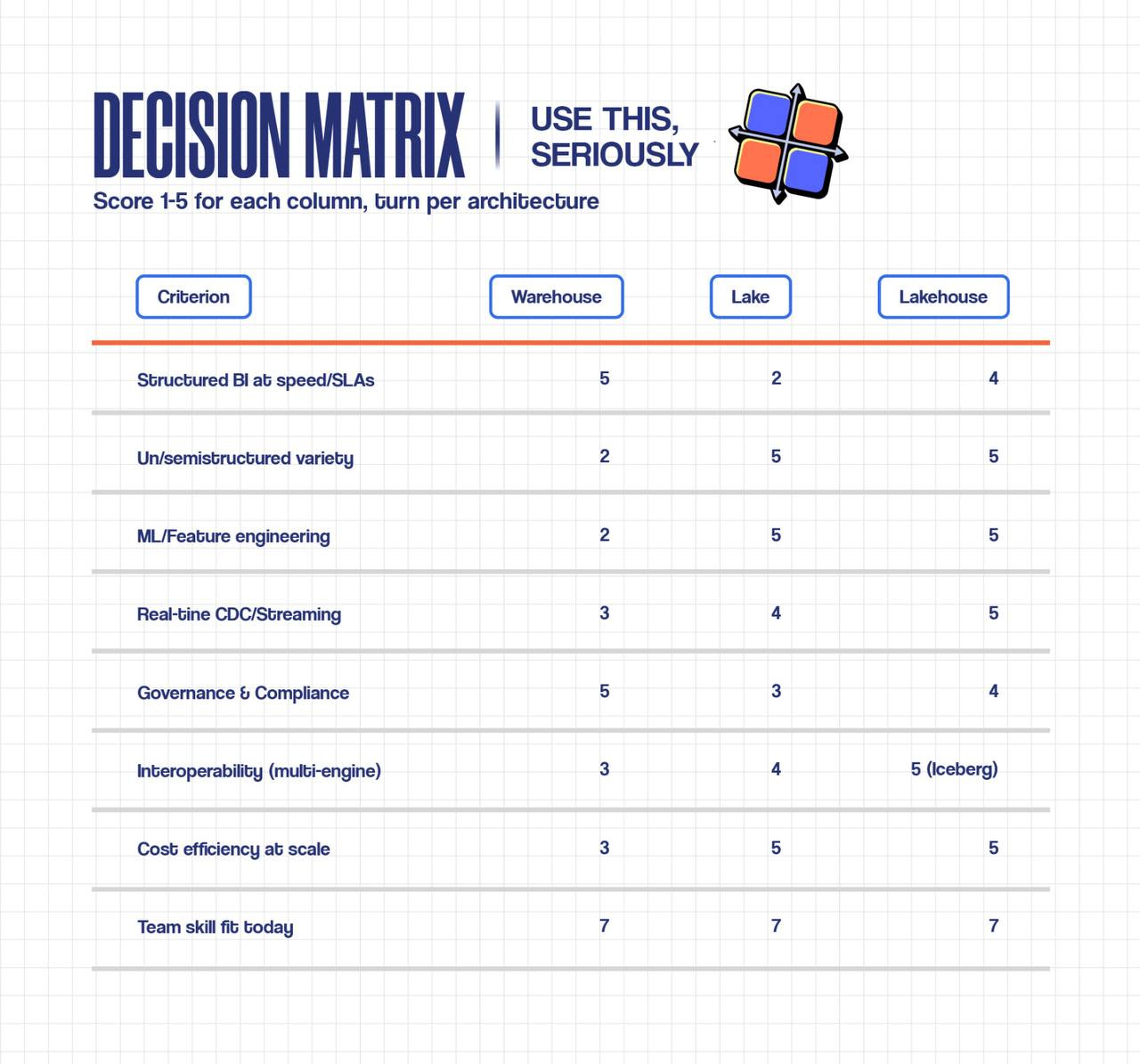Data Lake vs Data Warehouse vs Lakehouse The Definitive, Practical Guide
Data architecture breakdown: when each model wins (and when it doesn’t)
Warehouses = governed BI at speed.
Lakes = any data at low cost, ML-friendly, governance is on you.
Lakehouses = ACID tables on object storage, unify BI + ML, but require engineering maturity.
Most orgs run hybrids; the trick is getting governance, cost, and interoperability right.
1) Architecture Deep-Dive (How they’re actually built)
Data Warehouse (DW)
Storage/Compute: Columnar, MPP engine (e.g., Snowflake, Redshift, BigQuery, Synapse SQL).
Modeling: Schema-on-write, Kimball/Dimensional (facts/dims) or 3NF.
Workloads: Ad-hoc BI, dashboards, scheduled reports, and some ELT.
Governance: Built-in RBAC, row/column masking, auditing.
Ops Focus: Cost predictability, data contracts, release mgmt for schema changes.
Where it shines: financials, regulated reporting, and KPI stores for exec dashboards.
Data Lake (DL)
Storage: Object storage (S3/ADLS/GCS), raw + curated zones (bronze/silver/gold).
Compute: Spark, Presto/Trino, Flink; query with Athena/BigQuery external tables/Synapse Serverless.
Modeling: Schema-on-read; late binding; consistent conventions > rigid schemas.
Workloads: ML training, feature engineering, log analytics, streaming ingestion.
Governance: You assemble it (Lake Formation/Purview/Ranger + table-format ACLs + catalogs).
Where it shines: variety + volume at low $; experimentation; future-proof archiving.
Lakehouse (LH)
Storage: Object storage + ACID table formats (Delta/Iceberg/Hudi).
Compute: Spark/Trino/engine of choice; BI direct-query via connectors.
Table Formats (core differences):
Delta Lake: Transaction log on files; strong Spark/Dbrx ecosystem; features like OPTIMIZE, Z-ORDER, time travel.
Apache Iceberg: Hidden partitioning, snapshot isolation, strong multi-engine support (Snowflake/BigQuery/Redshift/Trino all leaning in).
Apache Hudi: Built-in upserts, incremental pulls, strong CDC ingestion patterns.
Catalog: Unity Catalog/Glue/Hive/Polaris/Tabular.
Workloads: BI + ML + streaming on the same physical tables.
Governance: Table-level RBAC/ABAC, row/column masking, lineage via OpenLineage, Purview/UC.
Where it shines: one copy, many engines; fewer pipelines; time travel; CDC-friendly.
2) Performance Engineering: What actually makes things fast
File layout
Target 128–1024 MB parquet/orc file sizes (avoid tiny files).
Use partitioning for high-cardinality but commonly filtered columns (e.g.,
date,region).For Delta/Iceberg, leverage clustering/sorting (Delta’s Z-ORDER or Iceberg sort orders) to speed selective queries.
Schedule compaction (OPTIMIZE/REWRITE DATA FILES) and vacuum old snapshots.
Query patterns
Precompute gold aggregates for BI; don’t make BI tools scan bronze.
Use materialized views/Delta Live Tables/DBT for hot paths.
Cache dim tables in the engine memory for star joins.
Streaming
For lakehouse: exactly-once via transactional sinks (Delta/Iceberg).
Tune micro-batch intervals, checkpointing, and watermarking for late data.
3) Governance & Security (non-negotiables)
Identity & Access: Centralize via IAM/AAD; enforce least privilege at table/column/row level.
Data Classification: Tag PII/PHI; propagate tags to policies (masking/deny).
Lineage & Observability: OpenLineage/Marquez, Databricks lineage, Purview; tie alerts to SLA/SLOs.
Quality Gates: Great Expectations/Soda/Deequ in pipelines; fail fast on contract breaches.
Audit & Retention: Time travel + WORM buckets for compliance; implement legal hold processes.
Keys & Secrets: KMS/Key Vault/Cloud KMS + envelope encryption; rotate and monitor use.
4) Cost Model Reality Check
Warehouses: Pay per compute slot/credit; egress for external tables; watch for BI concurrency spikes.
Lakes/Lakehouses: Cheap storage, compute is the bill—optimize compaction, cache, and file pruning.
Universal tips:
Autosuspend/auto-scale; use serverless only where bursty.
Tag workloads by domain/cost center; publish monthly FinOps dashboards.
Kill zombie clusters/jobs; enforce TTL on dev sandboxes.
5) Interoperability (avoid lock-in)
Prefer open table formats (Delta/Iceberg/Hudi) + open file formats (Parquet/ORC).
Separate catalog (Glue/Polaris/UC) from compute engines to swap engines later.
Standardize contracts at the domain boundary (Avro/Protobuf/JsonSchema), publish in a registry.
6) Concrete Reference Architectures
AWS
Warehouse: Redshift (RA3) + Spectrum; or Snowflake on AWS.
Lake: S3 + Glue Data Catalog + Lake Formation + Athena/EMR/Trino.
Lakehouse: S3 + (Delta/Iceberg/Hudi) + EMR/Databricks/Trino + Redshift/Snowflake connectors.
Streaming: MSK/Kinesis → Spark/Flink → Delta/Iceberg.
Azure
Warehouse: Synapse Dedicated SQL / Snowflake.
Lake: ADLS Gen2 + Synapse Serverless + Spark Pools/Databricks + Purview.
Lakehouse: ADLS + Delta/Iceberg on Databricks/Spark + Direct Lake (Fabric) for BI; Power BI semantic model.
Streaming: Event Hubs/Kafka → Structured Streaming/Flink → Delta.
GCP
Warehouse: BigQuery native.
Lake: GCS + Dataproc/Trino + BigLake external tables.
Lakehouse: Iceberg/Delta on GCS + BigQuery/Dataproc/Trino with the same tables.
Streaming: Pub/Sub → Dataflow/Flink/Spark → Iceberg/Delta.
7) Table Format Showdown (when to pick what)
Pragmatic pick:
Delta if you’re Spark/Databricks-centric.
Iceberg if you need many engines today/tomorrow.
Hudi if upserts/incrementals are your core workload.
8) Migration Patterns (and traps)
Warehouse → Lakehouse
Land raw to bronze; build silver with cleansed schemas; publish gold marts.
Dual-run key dashboards; validate row counts & aggregates.
Gradually point BI to lakehouse tables; keep warehouse for critical finance early on.
Lake → Lakehouse
Introduce table format (Delta/Iceberg/Hudi) on silver/gold only.
Back-fill historical partitions; set compaction schedule.
Add governed access and a proper catalog before inviting BI.
CDC ingestion
Use Debezium/DMS → Kafka/MSK → Spark/Flink to transactional tables.
Choose Hudi (MERGE-ON-READ) or Delta/Iceberg with efficient MERGE INTO patterns.
Common anti-patterns
BI pointed at bronze.
Millions of tiny files.
No data ownership (mesh principles), everything centralized.
Ignoring deletes/GDPR in immutable logs.
Over-partitioning (e.g., by user_id) causing hot metadata and slow planning.
9) Decision Matrix (use this, seriously)
If Lakehouse wins but your team skill fit is low, phase in with a dual-run hybrid for 6–12 months.
10) Operating Model: who owns what (RACI sketch)
Domain Teams (Data Product Owners): own schemas, SLAs, quality rules (R/A).
Platform Team: storage, catalogs, security baselines, CI/CD for data (R).
Governance/Compliance: policies, audits, retention (A).
BI/Analytics: semantic layer, certified dashboards (R).
Security: KMS, key rotation, access reviews (A).
Publish a data product spec per domain: purpose, contracts, lineage, SLOs, PII tags, owners.
11) SLOs & KPIs to track
Freshness SLO: e.g., <10 min for gold tables X/Y.
Quality KPIs: failed validation rate <0.5%; drift alerts/week.
Cost/FTE: $/TB/month by domain; $/1000 queries.
Reliability: pipeline success rate; mean time to recovery.
Adoption: % BI queries served from lakehouse vs warehouse.
12) What to implement first (90-day plan)
Days 0–30
Pick table format + catalog; define bronze/silver/gold.
Stand up ingest (batch + one streaming source) and governance baseline (RBAC, masking).
Ship one business-critical gold table + a certified dashboard.
Days 31–60
Add CDC for one key system; implement compaction/OPTIMIZE/VACUUM.
Integrate quality checks (Great Expectations) in CI/CD.
Publish cost dashboard + tagging.
Days 61–90
Expand BI coverage (semantic layer/metrics store).
Onboard a second domain; introduce time-travel audits.
Run deprecation plan for legacy copies.
FAQ (you’ll get asked)
Can a warehouse do ML? You can feature-engineer in SQL, but training/inference at scale usually moves to lake/lakehouse.
One stack to rule them all? Not in large enterprises. Aim for interoperable stacks, not monoculture.
Which is cheapest? Storage favors lake/lakehouse. Total cost depends on query patterns and governance.
Bottom Line
If you need clean BI with tight SLAs and limited data types → Warehouse.
If you need any data, ML, and low storage cost → Lake (but add governance).
If you want one copy for BI + ML with ACID and open formats → Lakehouse (with the skills to run it).
At scale, expect a hybrid—design for open formats, catalogs, and governance from day one.
Next in this series: Data Mesh vs Data Fabric—when to decentralize, how to govern, and how not to blow up your platform.




